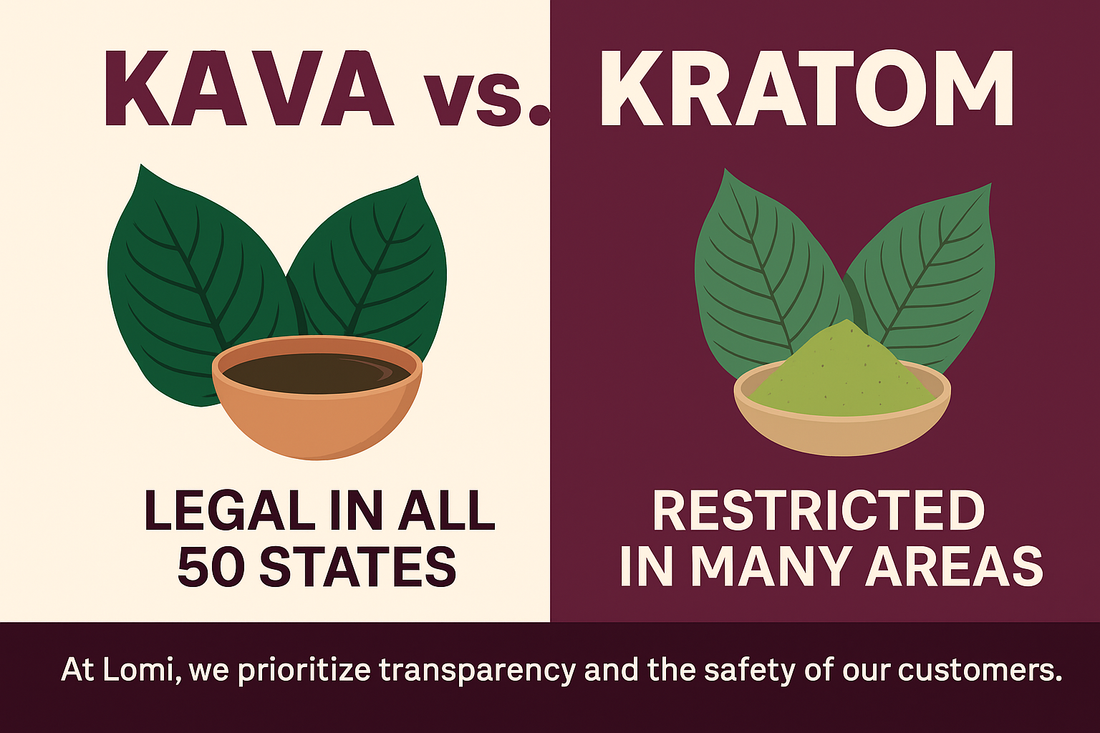
Kava vs. Kratom: What’s the Difference?
Share
If you’ve ever searched for natural ways to relax or boost your mood, you’ve probably come across both kava and kratom. While they’re often mentioned together, the reality is clear: kava is not the same as kratom. These two plants come from very different parts of the world, work in very different ways, and have very different effects on the body and mind.
What is Kava?
Kava is made from the root of the Piper methysticum plant, native to the South Pacific Islands. For centuries, it has been used in ceremonies and social gatherings for its calming properties. Its active compounds, kavalactones, work on the brain’s GABA receptors — helping to reduce stress, support relaxation, and promote sociability.
✅ Kava benefits:
- Promotes relaxation and calm
- Helps ease stress and tension
- Supports better sleep and mood balance
- Non-addictive and hangover-free
- Legal in all 50 states
What is Kratom?
Kratom comes from the leaves of the Mitragyna speciosa tree, native to Southeast Asia. Unlike kava, kratom’s effects vary dramatically based on dose and strain. Its compounds interact with opioid receptors in the brain, which can mimic the effects of opioids.
⚠️ Kratom risks:
- At low doses, it can act as a stimulant (increased energy/alertness)
- At high doses, it can act as a sedative with opioid-like effects
- Potential for dependency and side effects
- Not legal in every state — some U.S. states have banned kratom due to safety concerns
Key Differences: Kava vs. Kratom
- Plant source: Kava = root; Kratom = leaf
- Effects on the body: Kava = relaxation and calm; Kratom = stimulant OR sedative depending on dose
- Safety: Kava = non-addictive, federally recognized dietary supplement; Kratom = controversial, linked to dependency concerns, restricted in some states
- Cultural use: Kava = ceremonial and social tradition in the Pacific Islands; Kratom = historically used by laborers in Southeast Asia for stamina
Is Kava Safer Than Kratom?
Yes. While both are natural plants, kava has a long history of safe traditional use and is considered a dietary supplement in the U.S. Kratom, on the other hand, faces bans in some states due to its opioid-like activity and safety concerns.
If you’re looking for a safe, non-alcoholic way to relax, reduce stress, and stay social, kava is the clear choice.
Lomi’s Commitment to Transparency & Safety
At Lomi, we believe that wellness starts with trust. That’s why we prioritize transparency, quality ingredients, and customer safety above all else. Our sparkling beverages are made with kava, adaptogens like ashwagandha and lion’s mane, plus essential vitamins — carefully formulated to support balance and connection, without hidden risks.
✨ Bottom line: Kava and kratom are not the same. Kava supports relaxation and connection, while kratom carries very different — and sometimes risky — effects. Kava is legal nationwide, safe, and community-driven, making it the better option for mindful drinkers.
